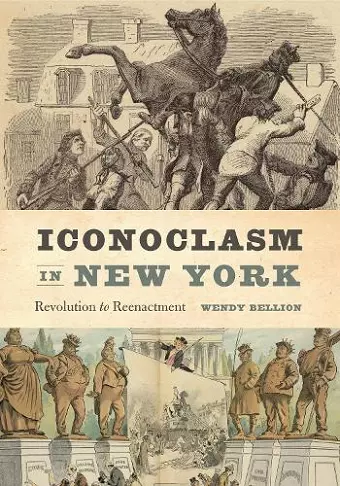Iconoclasm in New York
Revolution to Reenactment
Format:Paperback
Publisher:Pennsylvania State University Press
Published:30th Apr '21
Should be back in stock very soon
This paperback is available in another edition too:
- Hardback£111.99(9780271083643)

This book examines the destruction of King George III's statue in 1776, exploring its significance in shaping American identity and culture through iconoclasm.
This book delves into the theme of iconoclasm within American art history, particularly spotlighting the dramatic events surrounding the destruction of the statue of King George III in New York City in 1776. The author, Wendy Bellion, presents a compelling argument that the act of destroying art and historical objects has played a crucial role in shaping an American creation narrative. By examining this pivotal moment, she offers insights into the broader implications of such acts of defiance against established symbols of power and authority.
In Iconoclasm in New York, Bellion explores the aftermath of the statue's destruction, noting how it has continued to resonate in American culture. The statue, once a symbol of British rule, was not just toppled; its remnants were repurposed, with some parts buried and others melted down to create bullets. This act of defiance raises questions about the motivations behind the destruction and the subsequent re-emergence of King George III in various cultural representations. Bellion's inquiry into this phenomenon reveals a complex relationship between destruction and creation in the American consciousness.
The book situates the statue's downfall within a broader context of radical protest and material violence, tracing its legacy through visual representations and public performances. Bellion argues that this iconoclastic act was both a rejection of British influence and a paradoxical reaffirmation of cultural ties. Iconoclasm in New York is a persuasive exploration of how the destruction of British monuments helped forge a unique American identity, appealing to art historians, iconoclasm specialists, and general readers alike.
“A triumphant endorsement of the power of objects to act upon the human imagination.”
—Caroline Culp Panorama
“A timely study, given recent interest in removing Confederate statuary, this interdisciplinary volume will resonate with readers interested in history as well as those studying public monuments and memory. Highly recommended.”
—J. Decker Choice
“Bellion investigates many other pockets of American culture in her exploration of iconoclasm and its fractured meanings. The extent of her research is breathtaking, and her agile wit and engaging style keep the reader striding through the text. Somehow her command of theoretical work from a variety of disciplines manages to burnish rather than deaden the text. Eleven color plates and fifty-one black and white illustrations also give the reader plenty of visual material to ponder.”
—Benjamin L. Carp The Gotham Center for New York City History
“Vivid and visceral, Iconoclasm in New York weaves a brilliant tapestry of meanings from a moment of ritual violence in 1776 New York. Untangling the paradox of the always-toppling, never-quite-vanquished King George III, Wendy Bellion plumbs a central mystery of American culture. To see the destructive creation of the United States through Bellion’s keen eyes is to witness the American Revolution transformed.”
—Jane Kamensky, author of A Revolution in Color: The World of John Singleton Copley
“Wendy Bellion has one of the most powerful interpretive voices helping us see what the early United States imagined of itself and for itself. In her new book on the power of destructive acts, she looks closely at the art of destruction, showing us how King George III fell and rose (along with other emblems of monarchy and Great Britain) in a pattern that continues to this day. I’m looking forward to regularly reading, teaching, and thinking through Iconoclasm in New York.”
—Karin Wulf, author of Not All Wives: Women of Colonial Philadelphia
“Bellion’s provocative and timely study weaves together the geographic, environmental, political, and sensory landscapes of New York City to create a highly original contribution to scholarship on the American Revolution and its memorialization.”
—Matthew Dziennik The William and Mary Quarterly
“Meticulously researched and vividly written, Iconoclasm in New York provides a model for the field, demonstrating that the practice of art history can be at once expansive in scope and highly specific in its claims.”
—Catherine Roach Nineteenth-Century Art Worldwide
“Iconoclasm in New York will be indispensable to interdisciplinary scholarship on the episode and illuminating to work on American iconoclasm and commemoration. The abundant archival research is inestimable; the book is brimming with exciting discoveries and new features of what once seemed a familiar story. This deep history solidifies the pivotal role of iconoclasm in a myth of American origins.”
—Michelle Sizemore Early American Literature
“Bellion’s book helps me to contextualize and understand at least two forms of iconoclasm that we are experiencing today, both nationally and on a global scale: one that rejects monuments to white supremacy and imperialism and another that defends those monuments and would see anything that threatens them toppled in their stead.”
—Kirsten Pai Buick Winterthur Portfolio
ISBN: 9780271083650
Dimensions: 254mm x 178mm x 19mm
Weight: 544g
272 pages